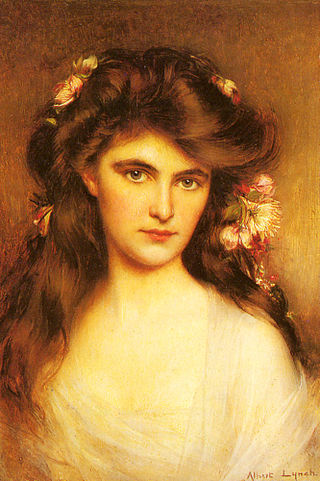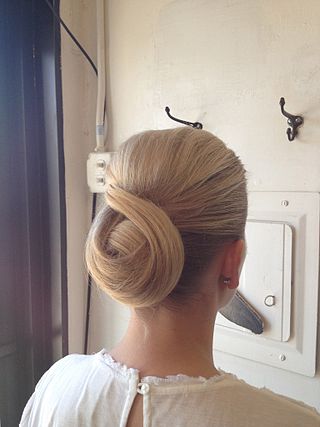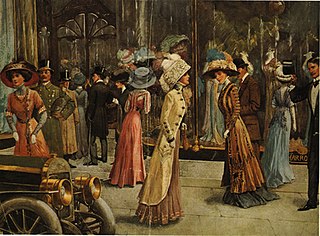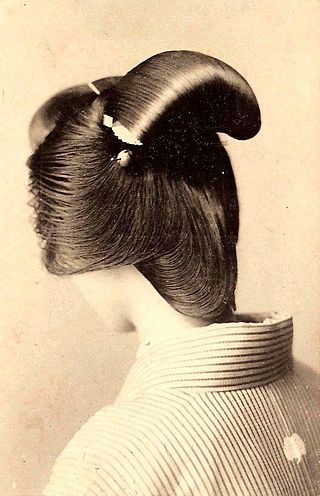
A hair receiver is a small pot, typically made of ceramic, bronze, or crystal, with a hole in the lid, kept on the dressing table in the Victorian era to store hair removed from brushes and combs. [1]

A hair receiver is a small pot, typically made of ceramic, bronze, or crystal, with a hole in the lid, kept on the dressing table in the Victorian era to store hair removed from brushes and combs. [1]
Hair receivers were a receptacle with a finger-wide hole in the top to allow for the collected hair to be fed into the box. The hair collected in these receivers was recycled in a number of ways, notably for stuffing small bags, about 8–10 centimetres (3–4 in) across, called ratts (or rats), [2] used to bulk out women's hairstyles. [3] [4] These ratts could also be made by weaving or plaiting the collected hair. [1] These ratts helped in achieving the high and filled out hairstyles which were fashionable in the Victorian era. The desire for changing the shape of the hair and head was linked, by one writer, to the Victorian fascination with phrenology. [2]
Some hair would be kept to make hair jewellery [5] and was also used for stuffing pincushions and small furnishing cushions as human hair was softer than the alternative, feathers. [2]
These receivers were often paired with a matching trinket box or a powder jar or as part of a dressing table set, made mainly from porcelain, though glass, metal, and celluloid were also used. Glass receivers were often topped with silver or silver plate. They were most commonly round or oval. [5]
The use of hair receivers fell into decline in the early 20th century, with shorter hairstyles becoming more fashionable. [6]

A hairpin or hair pin is a long device used to hold a person's hair in place. It may be used simply to secure long hair out of the way for convenience or as part of an elaborate hairstyle or coiffure. The earliest evidence for dressing the hair may be seen in carved "Venus figurines" such as the Venus of Brassempouy and the Venus of Willendorf. The creation of different hairstyles, especially among women, seems to be common to all cultures and all periods and many past, and current, societies use hairpins.

A hairstyle, hairdo, haircut, or coiffure refers to the styling of hair, usually on the human head but sometimes on the face or body. The fashioning of hair can be considered an aspect of personal grooming, fashion, and cosmetics, although practical, cultural, and popular considerations also influence some hairstyles.

A brooch is a decorative jewellery item designed to be attached to garments, often to fasten them together. It is usually made of metal, often silver or gold or some other material. Brooches are frequently decorated with enamel or with gemstones and may be solely for ornament or serve a practical function as a clothes fastener. The earliest known brooches are from the Bronze Age. As fashions in brooches changed rather quickly, they are important chronological indicators. In archaeology, ancient European brooches are usually referred to by the Latin term fibula. One example is the Tara Brooch

A pincushion is a small, stuffed cushion, typically 3–5 cm (1.2–2.0 in) across, which is used in sewing to store pins or needles with their heads protruding to take hold of them easily, collect them, and keep them organized.

Cornrows are a style of three-strand braids in which the hair is braided very close to the scalp, using an underhand, upward motion to make a continuous, raised row. Cornrows are often done in simple, straight lines, as the term implies, but they can also be styled in elaborate geometric or curvilinear designs. They are considered a traditional hairstyle in many African cultures, as well as in the African diaspora. They are distinct from, but may resemble, box braids, Dutch braids, melon coiffures, and other forms of plaited hair, and are typically tighter than braids used in other cultures.

Fashion in the 1890s in Western countries is characterized by long elegant lines, tall collars, and the rise of sportswear. It was an era of great dress reforms led by the invention of the drop-frame safety bicycle, which allowed women the opportunity to ride bicycles more comfortably, and therefore, created the need for appropriate clothing.

A bouffant is a type of puffy, rounded hairstyle characterized by hair raised high on the head and usually covering the ears or hanging down on the sides.

Fashion in the years 1750–1775 in European countries and the colonial Americas was characterised by greater abundance, elaboration and intricacy in clothing designs, loved by the Rococo artistic trends of the period. The French and English styles of fashion were very different from one another. French style was defined by elaborate court dress, colourful and rich in decoration, worn by such iconic fashion figures as Marie Antoinette.

Fashion in the period 1795–1820 in European and European-influenced countries saw the final triumph of undress or informal styles over the brocades, lace, periwigs and powder of the earlier 18th century. In the aftermath of the French Revolution, no one wanted to appear to be a member of the French aristocracy, and people began using clothing more as a form of individual expression of the true self than as a pure indication of social status. As a result, the shifts that occurred in fashion at the turn of the 19th century granted the opportunity to present new public identities that also provided insights into their private selves. Katherine Aaslestad indicates how "fashion, embodying new social values, emerged as a key site of confrontation between tradition and change."

A chignon, from the French chignon meaning a bun, is a hairstyle characterized by wrapped hair on the back of the head. In the United States and United Kingdom, it is often used as an abbreviation of the French phrase chignon du cou, signifying a low bun worn at the nape of the neck.

A lock of hair is a piece or pieces of human hair that are usually bunched or tied together in some way. A lock of hair can be on a person's head, or have been cut from the head. When attached to the head, a lock of hair generally refers to a tress, curl, or ringlet of hair. When cut from the head, a lock of hair may be kept for its symbolic value.

Fashion of the 1960s featured a number of diverse trends, as part of a decade that broke many fashion traditions, adopted new cultures, and launched a new age of social movements. Around the middle of the decade, fashions arising from small pockets of young people in a few urban centers received large amounts of media publicity, and began to heavily influence both the haute couture of elite designers and the mass-market manufacturers. Examples include the mini skirt, culottes, go-go boots, and more experimental fashions, less often seen on the street, such as curved PVC dresses and other PVC clothes.

A decorative box is a form of packaging that is generally more than just functional, but also intended to be decorative and artistic. Many such boxes are used for promotional packaging, both commercially and privately. Historical objects are usually called caskets if larger than a few inches in more than one dimension, with only smaller ones called boxes.

Fashion in the period 1900–1909 in the Western world continued the severe, long and elegant lines of the late 1890s. Tall, stiff collars characterize the period, as do women's broad hats and full "Gibson Girl" hairstyles. A new, columnar silhouette introduced by the couturiers of Paris late in the decade signaled the approaching abandonment of the corset as an indispensable garment.

A nightcap is a cloth cap worn with other nightwear such as pajamas, a onesie, a nightshirt, or a nightgown; historically worn in the cold climates of Northern Europe. Nightcaps are somewhat similar to knit caps worn for warmth outdoors.

Hairwork, or jewelry or artwork made of human hair, has appeared throughout the history of craft work, particularly to be used for private worship or mourning. From the Middle Ages through the early twentieth century, memorial hair jewelry remained common. Hair, considered to be a remnant off the person it was cut from, also has often played a part in myths and legends; in a Swedish book of proverbs, one can read that “rings and bracelets of hair increase love”. One example can be found in Denmark, at Rosensborg’s palace, which is a bracelet of precious metal with a simple braided lock of hair - a gift from King Christian IV (1577-1648) to his queen. Another example would be the rings commemorating the execution of King Charles I of England (1600-1649), which circulated among his faithful supporters. Other famous people who owned hair jewelry include Napoleon, Admiral Nelson, Queen Victoria and her large family, Christina Nilsson and Jenny Lind.

Nihongami is the term used for a number of traditional Japanese hairstyles considered to be distinctive in their construction and societal role.

A toilet service is a set of objects for use at the dressing table. The term is usually reserved for large luxury sets from the 17th to 19th centuries, with toilet set or vanity set used for later or simpler sets. Historically, services were made in metal, ceramics, and other materials, for both men and women, though male versions were generally much smaller. The rich had services in gold, silver, or silver-gilt. The contents vary, but typically include a mirror, one or more small ewers and basins, two candlesticks, and an assortment of bowls, boxes, caskets, and other containers. One or more brushes and a pin-cushion, often as a top to a box, are often included. The sets usually came with a custom-made travelling case, and some services were especially designed for travelling.

Box braids are a type of hair-braiding style that is predominantly popular among African people and the African diaspora. This type of hairstyle is a "protective style" and is "boxy", consisting of square-shaped hair divisions. Box braids are generally installed by using synthetic hair which helps to add thickness as well as helping the natural hair that is in the braid. Because they are not attached to the scalp like other similar styles such as cornrows, box braids can be styled in a number of different ways. The installation process of box braids can be lengthy, but once installed they can last for six to eight weeks. They are known for being easy to maintain.

Braids are a complex hairstyle formed by interlacing three or more strands of hair. Braiding has been used to style and ornament human and animal hair for thousands of years in various cultures around the world.